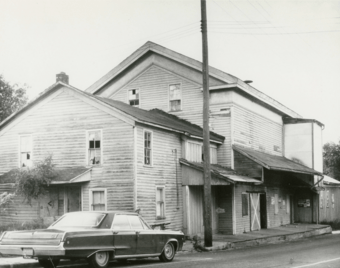Ortonville Mill facts for kids
Quick facts for kids |
|
|
Ortonville Mill
|
|
 |
|
| Location | 366 Mill St., Ortonville, Michigan |
|---|---|
| Area | less than one acre |
| Built | 1856 |
| Architectural style | Greek Revival |
| NRHP reference No. | 71000416 |
| Added to NRHP | April 16, 1971 |
The Ortonville Mill is a historic building in Ortonville, Michigan. It was once a busy gristmill, a place where farmers brought their grain to be ground into flour. This important building is located at 366 Mill Street. It was added to the National Register of Historic Places in 1971. Today, the Ortonville Community Historical Society takes care of the mill. They run it as a museum, sharing local history with everyone.
Contents
History of the Ortonville Mill
How the Mill Started
Amos Orton was born in 1809 in Hadley, New York. Around 1848, he came to Oakland County, Michigan. He built a sawmill very close to where the mill stands today. Sawmills cut logs into lumber.
In 1852, Amos Orton built a gristmill nearby. This made the area more attractive for new settlers. People needed a place to grind their crops. In 1856, he built the current mill structure. It replaced the older gristmill.
Ortonville Grows Around the Mill
The small town of Ortonville grew up around this milling center. Amos Orton was a very busy man. He worked as the miller, grinding grain for people. He was also a blacksmith, making and fixing metal tools. Plus, he ran a general store for the community.
The Mill Through the Years
Amos Orton stopped running the mill in 1860. But the mill kept working well for many years. It had different owners over time. In 1889, the mill was updated. It started using a new "roller process" to grind grain. This was a modern way to make flour.
For a short time in the 1920s, the mill also made electricity. It helped power the community. The mill continued to operate until 1960.
The Mill Becomes a Museum
In 1968, Emiline and Jack Hamilton gave the mill to the Ortonville Community Historical Society. They wanted it to become a museum. Now, the Society owns and takes care of the mill. It is a museum and a place for the community to gather.
What the Ortonville Mill Looks Like
The Ortonville Mill is a 2-1/2 story building. It is built in the Greek Revival style. This style often has features like columns and simple, strong shapes. The mill has a frame made from hand-cut timbers. It sits on a basement that is not paved.
The first part of the mill was 36 feet wide and 48 feet long. Later, a large room was added to the building. This made the total length 108 feet. Most of the original windows are "nine over six" sliding windows. This means they have nine small glass panes on the top and six on the bottom. There is also a roofed loading dock on one side. This was used for loading and unloading grain.

